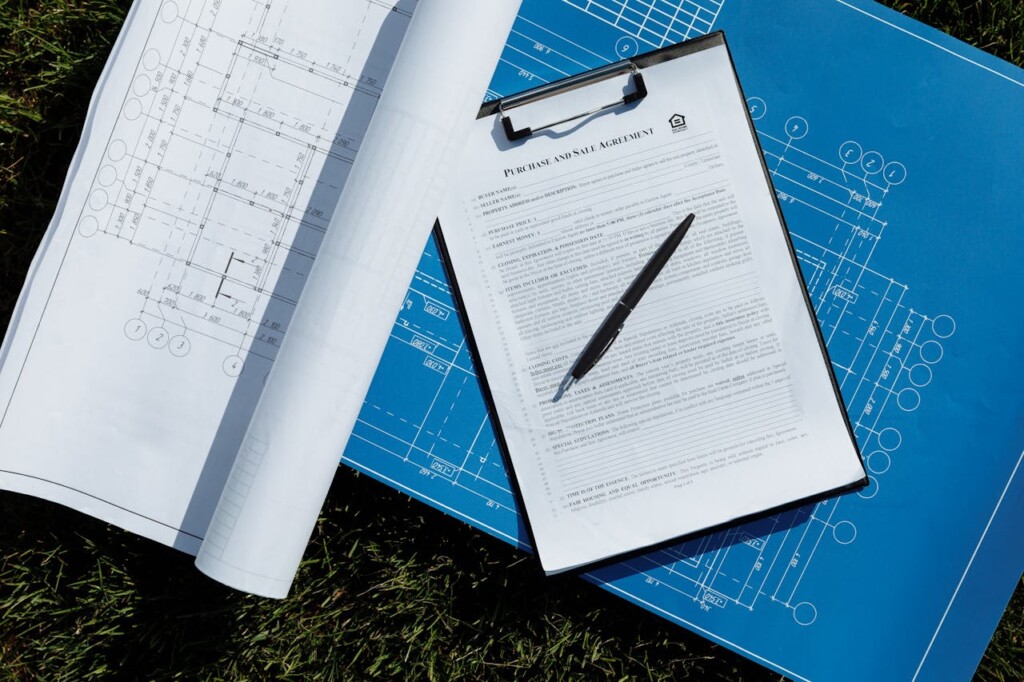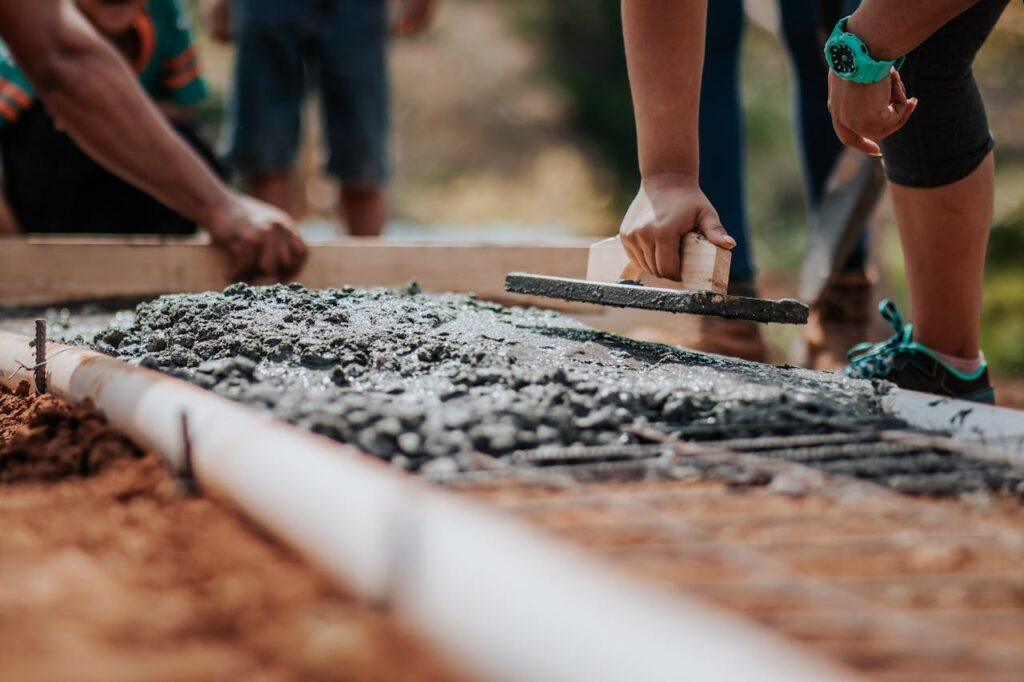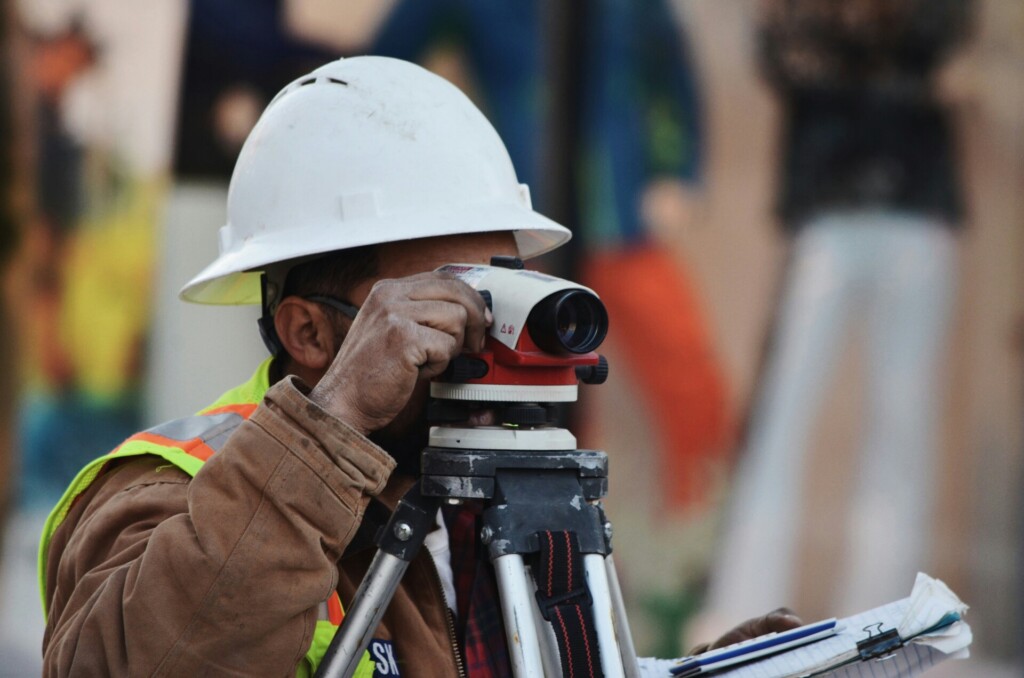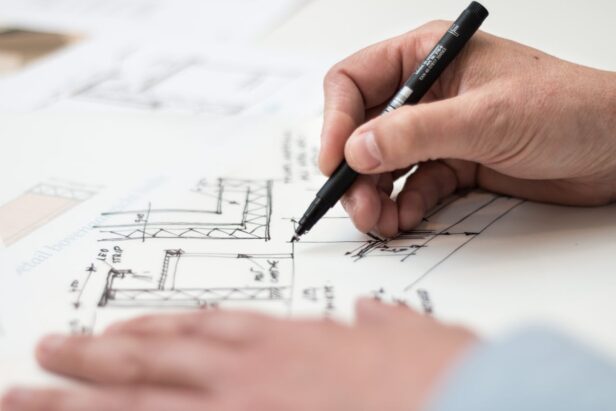Construction and building design work best as an integrated system where design vision becomes physical reality. Design defines the facility’s purpose, layout, and performance requirements. Construction transforms those concepts into functioning structures that serve developers and property owners for decades.
Most construction projects present unique challenges because they are custom, site-specific, and span extended timeframes. Early planning, precise scope definition, and constructability reviews reduce costly rework during construction. Strategic decisions around construction methods, material selection, and sustainable approaches directly influence long-term building performance. Advanced technologies like Building Information Modeling, prefabrication systems, and sensor networks now enhance coordination, accelerate project schedules, and improve jobsite safety throughout the construction process.
How Should Design And Construction Be Integrated From Day One?

Successful projects require design and construction to work as coordinated disciplines from initial planning through completion. We establish this integration by implementing structured processes that align technical decisions with field realities. The approach prevents costly changes and reduces delays by addressing potential conflicts before they reach the construction phase.
Early Constructability Reviews Drive Better Outcomes
We run constructability reviews at multiple design milestones to identify buildability issues while solutions remain cost-effective to implement. These reviews analyze structural connections, material availability, and construction sequencing against the design intent. Our construction professionals examine drawings and specifications to flag elements that may create field difficulties or require specialized equipment.
Constructability analysis evaluates whether proposed details can be executed with standard construction practices and available skilled labor. We assess access requirements for equipment and workers, particularly in tight urban sites or complex renovations. The review process also examines how different building systems interact during installation to prevent conflicts between mechanical, electrical, and structural components.
Structured Scope Definition Prevents Project Drift
We use Project Definition Rating Index (PDRI) checklists and similar structured tools to define project scope comprehensively before design work begins. This process captures owner requirements, site constraints, and performance criteria in measurable terms. Clear scope definition establishes the foundation for accurate cost estimates and realistic schedules.
Scope definition includes detailed programming that aligns space requirements with functional needs and operational workflows. We document quality standards, sustainability targets, and technology requirements to guide design decisions. The process also establishes change management procedures that maintain cost and schedule control throughout the project.
Clear Responsibilities Streamline Project Coordination
We establish specific responsibilities for shop drawings, construction scheduling, and review processes during the pre-construction phase. Each party understands their role in submittal preparation, review timelines, and approval workflows. This clarity prevents delays caused by unclear accountability or overlapping responsibilities.
Shop drawing coordination requires early identification of fabrication lead times and delivery schedules that affect the construction sequence. We coordinate submittal schedules with procurement activities to ensure materials and systems arrive when needed for installation. The process includes quality assurance protocols that verify shop drawings align with design intent and field conditions.
Strategic Risk Sharing Protects All Parties
We allocate project risks to the parties best equipped to manage them effectively. Subsurface conditions represent a common risk that requires careful investigation and appropriate contract language. Geotechnical investigation provides data for foundation design, but unknown conditions may still emerge during excavation.
Risk sharing strategies include contingency planning for site access limitations, utility conflicts, and environmental constraints. We establish protocols for addressing unforeseen conditions that allow projects to continue while changes are evaluated and priced. The approach maintains progress while protecting owner and contractor interests.
Site Investigation Validates Design Assumptions
We conduct thorough site visits to verify existing conditions and identify constraints that may affect construction methods or sequencing. These investigations examine utility locations, soil conditions, and adjacent structures that influence design decisions. Site analysis also evaluates access routes for equipment and materials, particularly for projects in dense urban areas.
Environmental factors such as noise restrictions, working hour limitations, and staging area availability affect construction planning and costs. We document these constraints early to inform design development and construction methodology. The process includes coordination with local authorities to understand permitting requirements and approval timelines.
Value Engineering Optimizes Project Investment
We apply value engineering principles systematically to identify cost savings without compromising performance or quality. This analysis evaluates alternative materials, systems, and construction methods against project requirements and long-term operational costs. Value engineering considers life-cycle performance rather than just initial construction costs.
The process examines each building system for opportunities to improve efficiency or reduce complexity while maintaining functionality. We evaluate material substitutions that offer comparable performance at lower cost or improved sustainability characteristics. Value engineering also reviews construction sequencing to identify time savings that reduce overall project costs.
Which Construction Methods Fit Different Goals And Constraints?
Selecting the right construction method depends on project goals, site conditions, building codes, and schedule requirements. We organize methods into three categories: traditional approaches that emphasize durability and proven performance, modern techniques that prioritize speed and efficiency, and sustainable solutions that reduce environmental impact while meeting structural requirements.
Traditional Construction Methods
Traditional methods form the foundation of construction practice. These time-tested approaches offer reliability and established code compliance paths.
Brick-and-mortar construction provides exceptional durability and fire resistance. The thermal mass of masonry walls helps regulate interior temperatures, while the material’s longevity makes it suitable for institutional and heritage projects. Load-bearing walls using masonry distribute structural loads directly to foundations, creating stable assemblies that perform well in seismic zones when properly reinforced.
Timber framing delivers flexibility for complex geometries and offers excellent seismic performance through its inherent ductility. Wood’s natural properties allow for thermal expansion and contraction without cracking, making it ideal for residential and low-rise commercial projects. The material’s renewability and carbon sequestration properties align with environmental goals.
Stone masonry represents the ultimate in longevity, with structures lasting centuries when properly constructed. Natural stone provides exceptional compressive strength and weather resistance. Cast-in-place concrete creates monolithic structures with high structural integrity, allowing for complex forms and providing excellent fire ratings and durability.
Modern Construction Methods
Modern approaches emphasize speed, precision, and waste reduction through factory-controlled processes and advanced materials.
Modular construction and prefabrication move assembly work to controlled factory environments. Factory-built components arrive on-site ready for installation, reducing weather delays and improving quality control. This method can cut construction schedules by 30-50% while generating less waste than traditional on-site assembly.
Twin-wall systems combine precast concrete skins with in-situ concrete cores, creating excellent thermal performance and structural strength. These systems work well for mid-rise residential and commercial projects where energy efficiency and speed matter. Flat slab construction eliminates beams, creating flexible floor layouts and reducing floor-to-floor heights while speeding concrete placement.
Steel frame construction provides exceptional strength-to-weight ratios, making it ideal for tall buildings and industrial facilities with long spans. Steel’s predictable properties and shop fabrication ensure precision assembly. 3D printing enables layered construction of complex geometries, offering customization opportunities for architectural features and specialized components.
Glass Fiber Reinforced Concrete (GFRC) creates lightweight façade systems with design flexibility. Self-healing concrete incorporates materials that automatically seal small cracks, reducing maintenance needs and extending service life.
Sustainable Construction Methods
Sustainable approaches integrate environmental considerations with structural performance, often delivering long-term operational benefits.
Green roofs and living walls provide insulation and stormwater runoff control while creating habitat and improving air quality. These systems work particularly well in urban environments where space is limited. Passive solar design uses building orientation and envelope strategies to minimize energy consumption for heating and cooling.
Cross-Laminated Timber (CLT) panels offer low-carbon alternatives to concrete and steel for mid-rise construction. These engineered wood products sequester carbon while providing excellent structural performance. Rammed earth construction uses local materials to create walls with high thermal mass, reducing energy needs in appropriate climates.
Recycled and upcycled materials reduce embodied energy while meeting structural requirements. Insulating Concrete Forms (ICF) combine concrete’s structural integrity with continuous insulation, creating highly energy-efficient wall systems.
Matching Methods To Project Requirements
We evaluate each project against specific criteria to determine the most appropriate method. Site conditions including soil bearing capacity, environmental constraints, and access limitations influence method selection. Building codes vary by jurisdiction and may favor certain approaches over others.
Program requirements such as span lengths, load requirements, and occupancy types guide structural system choices. Timeline constraints often point toward prefabricated or modular approaches when speed is critical. Budget considerations must account for both first costs and long-term operational impacts.
Climate conditions affect material selection and construction sequencing. Projects in harsh environments may benefit from factory-built components, while regions with abundant local materials might favor traditional approaches. Seismic zones require special attention to ductility and connection details regardless of the chosen method.
The most successful projects often combine multiple methods. A steel frame might incorporate precast concrete panels, green roof systems, and traditional masonry elements. This hybrid approach allows each system to perform where it excels while meeting diverse project requirements.
How Do Material Selection And Detailing Influence Performance And Durability?

Material selection drives building performance for decades after construction. The right choices support occupant comfort, reduce maintenance needs, and ensure structural integrity. Poor material decisions create problems that cost more to fix than prevent.
Aligning Materials With Project Requirements
Start with the project’s basic parameters. Occupancy type determines fire protection requirements and durability expectations. High-traffic buildings need materials that withstand wear and frequent cleaning.
Building size affects material choices through code requirements. Larger buildings typically require more fire-resistant construction and higher-performance assemblies. Small residential projects have more flexibility in material selection.
Climate conditions shape material performance. We select materials that handle local temperature swings, humidity levels, and weather exposure. A material that works well in Phoenix may fail in Seattle due to moisture differences.
Evaluating Environmental Impact
Every material carries environmental consequences from extraction to disposal. Embodied energy measures the total energy required to produce, transport, and install materials. Higher embodied energy materials should deliver proportional performance benefits.
Source location matters for both cost and environmental impact. Local materials reduce transportation costs and support regional economies. However, we balance locality with performance requirements.
VOC emissions affect indoor air quality during and after construction. Low-VOC materials improve occupant health, particularly in tight building envelopes. We prioritize materials with verified emissions data.
Service life planning reduces life-cycle impacts. Durable materials with long service lives often justify higher initial costs through reduced replacement frequency. Plan for end-of-life scenarios including reuse and recycling potential.
Assessing Physical Properties
Strength requirements vary by application and load conditions. We match material strength to structural demands while avoiding over-specification. Compression, tension, and shear properties guide selection for different building elements.
Thermal conductivity affects energy performance and occupant comfort. Low-conductivity materials reduce heat transfer and improve building envelope performance. Mass and density influence thermal storage capacity.
Surface properties matter for durability and maintenance. Texture affects cleaning requirements and wear patterns. Color selection considers fading, heat absorption, and aesthetic longevity.
Detailing For Long-Term Performance
Joint design determines assembly durability. We detail connections to handle thermal movement, moisture penetration, and structural loads. Proper joint sealing prevents water infiltration and air leakage.
Interface details between different materials require careful attention. Dissimilar materials expand and contract at different rates. Detail these transitions to prevent cracking and separation.
Drainage details protect assemblies from water damage. We design positive drainage away from building elements and provide backup systems for primary drainage failure.
Construction Quality And Weathering
Skilled installation affects material performance regardless of quality. We specify materials within local contractor capabilities and provide clear installation requirements. Poor installation negates good material selection.
Weathering patterns should align with design expectations. Some materials age gracefully and develop character over time. Others require maintenance to preserve appearance and performance.
Maintenance access affects long-term serviceability. We detail assemblies for inspection and repair access. Sealed assemblies should last their full service life without maintenance intervention.
Which Technologies Are Raising Quality, Speed, And Safety?
Technology transforms how we approach coordination, scheduling, and risk management in construction. These digital tools enhance our ability to catch conflicts before they occur, monitor progress in real-time, and execute work with greater precision.
BIM And 4D Simulation For Enhanced Coordination
BIM creates a comprehensive digital model that serves as the foundation for effective project coordination. We use this technology to identify and resolve clash detection issues before construction begins, saving significant time and cost on-site.
4D simulation adds the time dimension to BIM models, enabling us to visualize construction sequences and optimize scheduling. This time-aware planning helps us anticipate workflow conflicts and coordinate trades more effectively throughout the project timeline.
BIM’s data-rich environment supports informed decision-making by providing immediate access to specifications, material properties, and dimensional information. Teams can collaborate more efficiently when everyone works from the same digital source of truth.
Digital Twins For Real-Time Operations
Digital twins create virtual replicas of physical assets that update continuously through sensor data and field inputs. We use these models to monitor building performance during construction and support long-term operations and maintenance scheduling.
These systems enable predictive maintenance by analyzing performance patterns and identifying potential issues before they become costly problems. The real-time data connection between physical and digital assets provides insights that improve both construction quality and operational efficiency.
Digital twins excel in complex projects where multiple systems interact, allowing us to simulate various scenarios and optimize performance throughout the building lifecycle.
Drones And Robotics For Speed And Precision
These aerial platforms generate accurate topographical maps and 3D models that support better site planning and resource allocation. Regular drone flights provide objective progress tracking that helps identify potential delays early in the construction process.
Robotics automate repetitive and physically demanding tasks, from rebar tying to material handling. Robotic systems perform these operations with consistent precision while reducing worker fatigue and exposure to hazardous conditions.
Automated equipment can operate continuously, extending productive hours beyond traditional work schedules. This capability proves particularly valuable for time-sensitive operations like concrete pours or critical path activities.
AI And Predictive Analytics For Risk Management
AI systems analyze vast amounts of project data to identify patterns and predict potential issues before they impact schedules or budgets. We use predictive analytics to optimize resource allocation and anticipate supply chain challenges.
Computer vision technology processes site photographs and video feeds to track progress, identify safety violations, and verify installation quality. These systems provide continuous monitoring capabilities that supplement human oversight.
Data analytics transform historical project information into actionable insights for future work. Machine learning algorithms help us understand which factors most influence project success and adjust our approaches accordingly.
Wearables And Sensors For Safety Enhancement
Wearable technology monitors worker health and location while providing real-time alerts about potential hazards. Smart helmets and safety vests equipped with sensors can detect falls, measure environmental conditions, and track worker movement patterns.
Environmental sensors throughout the job site monitor air quality, noise levels, and weather conditions that affect both worker safety and material performance. This remote monitoring capability enables proactive responses to changing conditions.
Connected safety systems integrate with project management platforms to provide comprehensive oversight of site conditions and worker well-being. Real-time data feeds help us maintain safer work environments and respond quickly to emerging risks.
Integrated Project Management Platforms
Project management software centralizes schedules, costs, and reporting in unified platforms accessible to all project stakeholders. These systems eliminate information silos and improve communication across teams and organizations.
Cloud-based collaboration tools enable real-time updates and document sharing regardless of location. Field teams can access current drawings, specifications, and project communications from mobile devices, reducing delays caused by outdated information.
Advanced project management platforms integrate with BIM models, accounting systems, and field data collection tools to provide comprehensive project oversight and control.
Prefabrication And Industrialized Construction
Prefabrication shifts construction work from unpredictable job site conditions to controlled factory environments where quality and productivity can be optimized. We coordinate factory production schedules with site preparation to minimize installation time.
Industrialized construction methods standardize processes and components while maintaining design flexibility. These approaches reduce material waste, improve quality consistency, and accelerate project delivery.
Factory-controlled environments enable precision manufacturing techniques that would be difficult or impossible to achieve in field conditions. Weather delays and site constraints have minimal impact on prefabricated component production.
Strategic Technology Adoption
We evaluate new technologies based on their fit with existing workflows, team capabilities, and regulatory requirements. Successful implementation requires careful consideration of training needs, integration complexity, and expected return on investment.
Pilot projects allow us to test new tools on a limited scale before committing to broader adoption. This measured approach helps identify the most effective applications and avoid costly implementation mistakes.
Technology selection should align with specific project goals and constraints rather than pursuing innovation for its own sake. The most valuable tools solve real problems and enhance human capabilities rather than replacing experienced judgment entirely.
Conclusion and Next Steps for Construction and Building Design

Successful construction and building design requires seamless integration from project inception through completion. We approach every project by combining design vision with construction reality, ensuring both work together to deliver optimal outcomes. The strategies we’ve outlined create a foundation for projects that meet schedule, budget, and performance goals while minimizing risk and rework.
Effective construction and building design follows a clear playbook. Start with integrated planning that brings design and construction teams together early. Define project scope using structured methodologies like PDRI to prevent costly changes later. Conduct regular constructability reviews to catch issues before they become problems. Select construction methods based on site conditions, program requirements, building codes, and project timeline. Choose materials that perform well in the local climate while meeting durability, safety, and environmental standards. Apply value engineering to optimize costs without compromising quality or performance. Deploy BIM, 4D simulation, sensors, and prefabrication strategically where they enhance coordination, accelerate schedules, and improve safety outcomes.
Ready to implement integrated construction and building design on your next project? Contact EB3 Construction to discuss how we can bring design and construction together for superior results.




